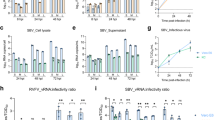Summary
Agarose in situ digestion was used to prepare intactAmsacta moorei entomopoxvirus (AmEPV) DNA from embedded occlusion bodies (OBs). Direct dissolution of OBs in agarose eliminated the necessity for separate purification of virions. A physical map of AmEPV DNA was constructed for five restriction enzymes (BamHI,EcoRI,HindIII,PstI, andXhoI) using single and multiple digests, and isolated fragment digestions. End fragments were identified by Bal31 digestion and snap-back analysis. A least squares procedure was used to reconcile fragment lengths. AmEPV genome size estimates were based on restriction enzyme (REN) fragment length totals (222 kb), reconciled physical map distance (225 kb), and field inversion gel electrophoresis (FIGE) (about 242 kb). Presumably due to the high A+T content (18.5% G+C) of AmEPV DNA, FIGE values for the intact genome and large REN fragments were about 6 to 10% higher than expected. Preparative FIGE was used to concentrate AmEPV DNA from agarose microbead encapsulated insect cells (Estigmene acrea, BTI-EAA). REN digests of this DNA were identical to those from OBs from caterpillars.
Similar content being viewed by others
References
Allington WB, Cordry AL, McCullough GA, Mitchell DE, Nelson JW (1978) Electrophoretic concentration of macromolecules. Anal Biochem 85: 188–196
Arif BM (1984) The entomopoxviruses. Adv Virus Res 29: 195–213
Bergoin M, Dales S (1971) Comparative observations on poxviruses of invertebrates and vertebrates. In: Maramorosch K, Kurstak E (eds) Comparative virology. Academic Press, New York, pp 169–205
Bernards A, Kooter JM, Michels PAM, Moberts RMP, Borst P (1986) Pulsed field gradient electrophoresis of DNA digested in agarose allows the sizing of the large duplication unit of a surface antigen gene in trypanosomes. Gene 42: 313–322
Bostock CJ (1988) Parameters of field inversion gel electrophoresis for the analysis of pox virus genomes. Nucleic Acids Res 16: 4239–4252
Carle GF, Frank M, Olson MV (1986) Electrophoretic separations of large DNA molecules by periodic inversion of the electric field. Science 232: 65–68
Crouse J, Amorese D (1987) Ethanol precipitation: ammonium acetate as an alternative to sodium acetate. Focus 9: 3–5
Dawkins HJS, Ferrier DJ, Spencer TL (1987) Field inversion gel electrophoresis (FIGE) in vertical slabs as an improved method for large DNA separation. Nucleic Acids Res 15: 3634–3635
Dougherty EM (1987) Insect viral control agents. In: Pierce G (ed) Developments in industrial microbiology, vol 28. Elsevier, New York, pp 63–75
Funahashi S, Sato T, Shida H (1988) Cloning and characterization of the gene encoding the major protein of the A-type inclusion body of cowpox virus. J Gen Virol 69: 35–47
Granados RR (1973) Insect poxviruses: pathology, morphology and development, Misc Publ Entomol Soc Am 9: 73–94
Granados RR (1981) Entomopoxvirus infections in insects. In: Davidson EW (ed) Pathogenesis of invertebrate microbial diseases. Allanheld, Osmun & Co, Totowa, NJ, pp 101–126
Granados RR, Roberts DW (1970) Electron microscopy of a poxlike virus infecting an invertebrate host. Virology 40: 230–243
Langridge WHR (1983a) Virus DNA replication and protein synthesis inAmsacta moorei entomopoxvirus-infectedEstigmene acrea cells. J Invertebr Pathol 41: 341–349
Langridge WHR (1983b) Partial characterization of DNA from five entomopoxviruses. J Invertebr Pathol 42: 369–375
Langridge WHR, Bozarth RF, Roberts DW (1977) The base composition of entomopoxvirus DNA. Virology 76: 616–620
Langridge WHR, Oma E, Henry JE (1983) Characterization of the DNA and structural proteins of entomopoxviruses fromMelanoplus sanguinipes, Arphia conspirsa, andPhoetaliotes nebrascensis (Orthoptera). J Invertebr Pathol 42: 327–333
Langridge WHR, Roberts DW (1977) Molecular weight of DNA from four entomopoxviruses determined by electron microscopy. J Virol 21: 301–308
Maniatis T, Fritsch EF, Sambrook J (1982) Molecular cloning. A laboratory manual. Cold Spring Harbor Laboratory, New York, p 545
Maniloff J (1989) Anomalous values ofMycoplasma genome sizes determined by pulsefield gel electrophoresis. Nucleic Acids Res 17: 1268
Matthews REF (1982) Classification and nomenclature of viruses. Fourth report of the International Committee on Taxonomy of Viruses. Intervirology 17: 4–199
McCarthy WJ, Granados RR, Roberts DW (1974) Isolation and characterization of entomopox virions from virus-containing inclusions ofAmsacta moorei (Lepidoptera: Arctiidae). Virology 59: 59–69
Overhauser J, Radic MZ (1987) Encapsulation of cells in agarose beads for use with pulsed-field gel electrophoresis. Focus 9: 8–9
Patel DD, Pickup DJ, Joklik WK (1986) Isolation of coxpox virus A-type inclusions and characterization of their major protein component. Virology 149: 174–189
Perbal B (1984) A practical guide to molecular cloning. Wiley, New York, p 554
Plikaytis BD, Carlone GM, Edmonds P, Mayer LW (1986) Robust estimation of standard curves for protein molecular weight and linear-duplex DNA base-pair number after gel electrophoresis. Anal Biochem 152: 346–364
Roberts DW, Granados RR (1968) A poxlike virus fromAmsacta moorei (Lepidoptera: Arctiidae). J Invertebr Pathol 12: 141–143
Schroeder JL, Blattner FR (1978) Least-squares method for restriction mapping. Gene 4: 167–174
Schwartz DC, Cantor CR (1984) Separation of yeast chromosome-sized DNAs by pulsed field gradient gel electrophoresis. Cell 37: 67–75
Smith CL, Cantor CR (1987) Purification, specific fragmentation, and separation of large DNA molecules. Methods Enzymol 155: 449–467
Smith CL, Lawrance SK, Gillespie GA, Cantor CR, Weissman SM, Collins FS (1987) Strategies for mapping and cloning macroregions of mammalian genomes. Methods Enzymol 151: 461–489
Van den Berg FM, Jiwa M, Rook R, Geelen JLMC (1988) Analysis and isolation of cytomegalovirus DNA by field inversion gel electrophoresis. J Gen Virol 69: 699–704
Willis A, Delange AM, Gregson C, Macaulay C, McFadden G (1983) Physical characterization and molecular cloning of the Shope fibroma virus DNA genome. Virology 130: 403–414
Zassenhaus HP, Butow RA, Hannon YP (1982) Rapid electroelution of nucleic acids from agarose and acrylamide gels. Anal Biochem 125: 125–130
Author information
Authors and Affiliations
Rights and permissions
About this article
Cite this article
Hall, R.L., Hink, W.F. Physical mapping and field inversion gel electrophoresis ofAmsacta moorei entomopoxvirus DNA. Archives of Virology 110, 77–90 (1990). https://doi.org/10.1007/BF01310704
Received:
Accepted:
Issue Date:
DOI: https://doi.org/10.1007/BF01310704




